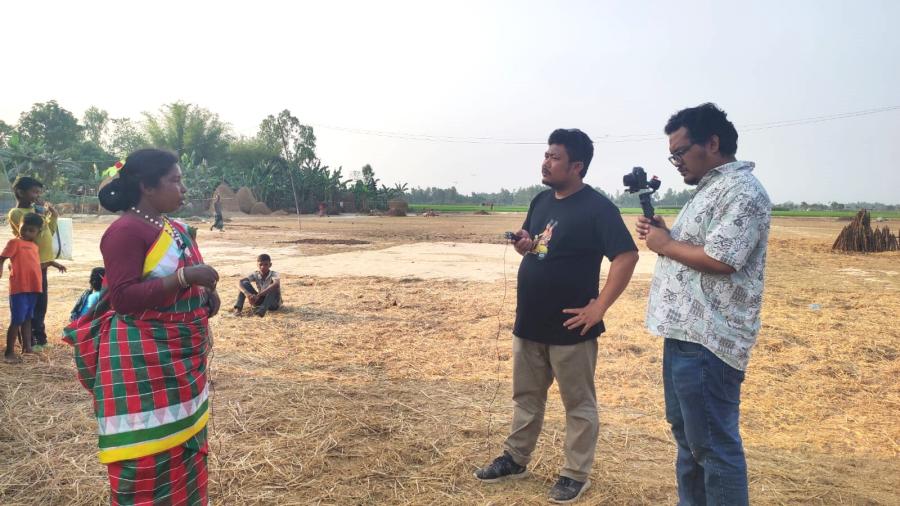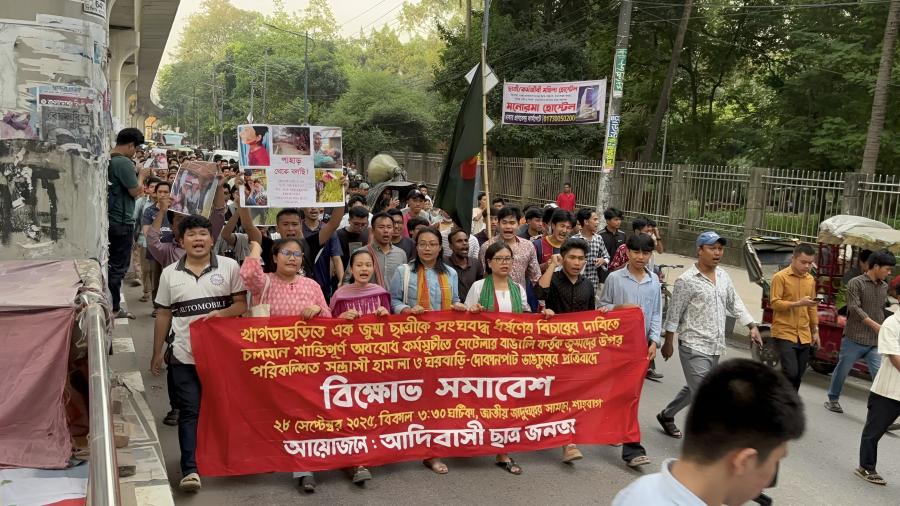Resource Development and Ethnic Conflict
Although Bangladesh's population consists mostly of Muslim, Bengali speakers, it also contains a variety of other ethnic groups (see Table). Most of these groups inhabit the district known as the Chittagong Hill Tracts, a region of hills and forests which was comparatively inaccessible until recently. Over the past century, however, the Hill Tracts have experienced rapid population growth due to immigration from the lowlands of Bengal. The economic attractiveness of the region's forest areas, competition for its agricultural land, and the energy potential of its water resources have resulted in ethnic conflict and policy dilemmas.
The Hill Tracts: Geography, Ethnicity and Administration
The Hill Tracts is the largest of Bangladesh's administrative districts, comprising more than 9 percent of the nation's territory; yet, the district's half million inhabitants (1974) represent only a tiny fraction of the nation's 72 million inhabitants. In 1974 the 350,000 "tribal" peoples, encompassing at least twelve ethnic groups, constituted about 70% of the Hill Tracts' population. Two ethnic groups predominate: the Chakmas, concentrated in the district's center, and the Marmas, found in the north and the south. Both of these groups have undergone greater acculturation to dominant South Asian traditions than other ethnic groups in the area. The Marmas retain their Arakanese dialect and are predominantly Buddhist; the Chakma appear long ago to have adopted their own dialect of Bengali, and though commonly described as Buddhists, they have accepted much Hindu ceremonial practice and belief.
Under British control the Hill Tracts were made into a separate district in 1860; by special regulation in 1900 the district was declared an "excluded area" under direct control of the Provincial Governor of Bengal. From then on, the three administrative subdivisions of the district were controlled by the major "tribal chiefs" - or rajas. Revenue collecting and dispute settlement functions were allocated to the chiefs/rajas (one Chakma and two Marma), who exercised these roles through a hierarchy of sub-collectors and village headmen.
The Tribal Population of the Chittagong Hill Tracts of Bangladesh [1960*]
Chakma 125,000
Marma 66,000
Tippera 37,000
Mru 16,000
Tanchangya 8,000
Chaks < 2,000
Kumis < 2,000
Kuki/Lushais < 2,000
Khyang < 2,000
Pankho < 2,000
Bangoji < 2,000
Mrung < 2,000
* Estimates based on summaries by Bessaignet [1958:1] compared with Bernot [1967(1):25-28].
Relations between Hill Tract ethnic groups and increasing Bengali plainsmen have always been strained. Bengalis have long controlled the bazaar and forest products trade. Early British accounts attest to the economic havoc wrought upon the hill people by Bengali money-lenders and to the increasing encroachment in the district by Bengali peasants from the heavily populated plains. In 1867 legislation was enacted which attempted to curtail the impact of moneylenders; the regulation of 1900 also attempted to control immigration and land settlement in order to protect the hill people. However, the population of the Hill Tracts has expanded at a far more rapid rate than that of any other district, the apparent result of immigration.
The Hill Tracts as a Forest Resource Area
About 8,750 square miles, or 16 percent of Bangladesh's territory, is classified as forest - half lies in the Chittagong Hill Tracts. The British established the first forest reserves in 1875, aimed at conservation through the prohibition of swidden (slash and burn) cultivation and control of timber cutting. At present there are five reserves covering some 1,000 square miles or 20 percent of the district's area. Its remainder is designated as "Unclassed State Forest".
Early British accounts of the region suggest that forest products were of long-standing significance in hills-plains trade. Firewood and bamboo are still major exports from the Hill Tracts, as are certain timber varieties used in construction and furniture making. But despite its potential in forest products, the inaccessibility of the Hill Tracts' forests and the inability of successive governments to invest in their development has resulted in under-exploitation of the region. Successive government plans, focusing on the Hill Tracts, have called for significant road building and modern equipment purchase, aimed at eventual increase in forest products.
Because of its potentially harmful effects for the forests - particularly in overpopulated areas - swidden cultivation has long been disparaged by governments. Although a majority of the hill people no longer engage in swidden agriculture, they remain identified with the practice in the minds of many Bengalis, who perceive it, along with other customs they find repugnant, as evidence of cultural inferiority. Such attitudes cannot help but have had some detrimental influence on the implementation of government policy toward the hill peoples.
Water Resource Development and the Heightening of Ethnic Conflict
Although Bangladesh lies in one of the world's great riverine areas, its major waterways have little energy potential - their average fall is only 60 feet. The smaller river systems of the Hill Tracts attracted attention for their energy potential as early as 1906, when the possibility of capturing the flow of the Karnafuli River was first explored. In 1956, dam construction was begun at Kaptai. Completed in 1961, the Karnafuli project has operated to date with a generating capacity of 80,00 KW, providing over 25 percent of Bangladesh's total electricity output. The creation of the Kaptai reservoir, however, inundated an area of 254 square miles, including 40% of the best agricultural land in the Chittagong Hill Tracts and about 6.5 % of the district's forests.
Preliminary estimates suggested that 80,000 people would have to be moved from the reservoir area; the actual number moved was more than 100,000. Of this number, 55 percent were plough cultivators inhabiting the Karnafuli and lower Chengri Valleys; the rest were swidden agriculturalists. The vast majority of all those affected were Chakmas, at least two-thirds of whose population resided in the area subject to flooding.
Eventually 20,000 to 22,000 acres of flatland in the Kasalong Forest Reserve were made available for resettlement of the plough cultivating population. However, this land amounted to less than 40% of that inundated. The result was a net reduction in the average land holding of six acres per family to approximately 2.5 acres, although a 10-acre minimum per family had been established by the government. Thirty percent of the non-Bengali families from the inundated area chose to relocate in the Kasalong Reserve, where some 570 Bengali households had already been resettled on the best land. Over half of the Chakmas and other hill people chose to move to higher ground in the reservoir area.
Ethnic Resistance and the Militarization of the Hill Tracts
Observers agree that the Karnafuli project - no doubt the culminating point of hill peoples' resentment to decades of forest conservation policy and the increasing encroachment of Bengali plains immigrants - engendered the separatist movement which surfaced in Bangladesh in the early 1970s.
In 1957 student groups, representing a new wave of Chakma and Marma political consciousness, began to organize an underground political party. By 1972, these groups had either merged with or allied themselves to the PCJSS (Chittagong Hill Tracts People's Solidarity Association). They met with officials to press a four-point statement of demands - autonomy of the Hill Tracts district complete with its own legislature, a reinstitution of the regulation of 1900 which had set the region apart as an "excluded area," a re-establishment of the system of indirect rule by the "chief/rajas" and a ban on immigration from outside the district. Reiterated to subsequent Bangladesh governments after 1975, these proposals met with considerable resistance in Dhaka. The demands, in turn, became more radical. The groups then called for constitutional self-determination to guarantee the "national identity" of the hill people. The newer demands included the prevention of further immigration from the plains and the expulsion of all Bengali settlers from the hills - demands which no Bengali, Bangladesh government can accept.
By May 1983, 14,000 government troops were reportedly deployed in the Hill Tracts against an estimated 3,000 rebels; since the inception of fighting in the 1970s, some 5,000 combatants and significant numbers of non-combatants have died. The conflict has sent an influx of Chakmas into India's neighboring Union Territory of Mizoram, now 30,000 strong, engendering concern over potential Mizo-Chakma ethnic conflict. Army activities in late 1981 also pushed some 25,000 Chakmas into India's Tripura State, with subsequent bi-governmental efforts to repatriate the refugees.
Meanwhile, settlement from the plains continues with government sanction. "We cannot afford the luxury," a senior settlement official has been quoted as saying, "of leaving that expansive hilly land unexploited while people are crammed in the plains like sardines." In early 1983, the martial law government in Dhaka moved to establish and arm Village Defence Police among the new settlers, to upgrade the weapons used by regular security forces, and to set up a jungle warfare training school for police personnel. This increasing militarization of the Hill Tracts has been aided by an expanded road-building program with UN and Australian aid. In October 1983, however. President H.M. Ershad announced a program of amnesty for the rebels, effective until February 1984. It includes the offer of one year's grant of food and money income upon surrender, five acres of land for those wishing to cultivate, employment in the security forces for the willing and able, training abroad for those seeking non-agricultural employment, and full political participation at the local level. Whether this offer will be taken up by the rebels in significant numbers or otherwise lead them to abandon their cause remains to be seen.
Conclusion
The Chittagong Hill Tracts situation raises complex questions of land use, ownership, settlement and regional autonomy in Bangladesh. Justifiable government efforts to utilize natural resources effectively, create conflict between politically dominant ethnic groups and cultural minorities with historical and legitimate claims to these resources. Given history to date, the future of the latter is not optimistic.
Article copyright Cultural Survival, Inc.


